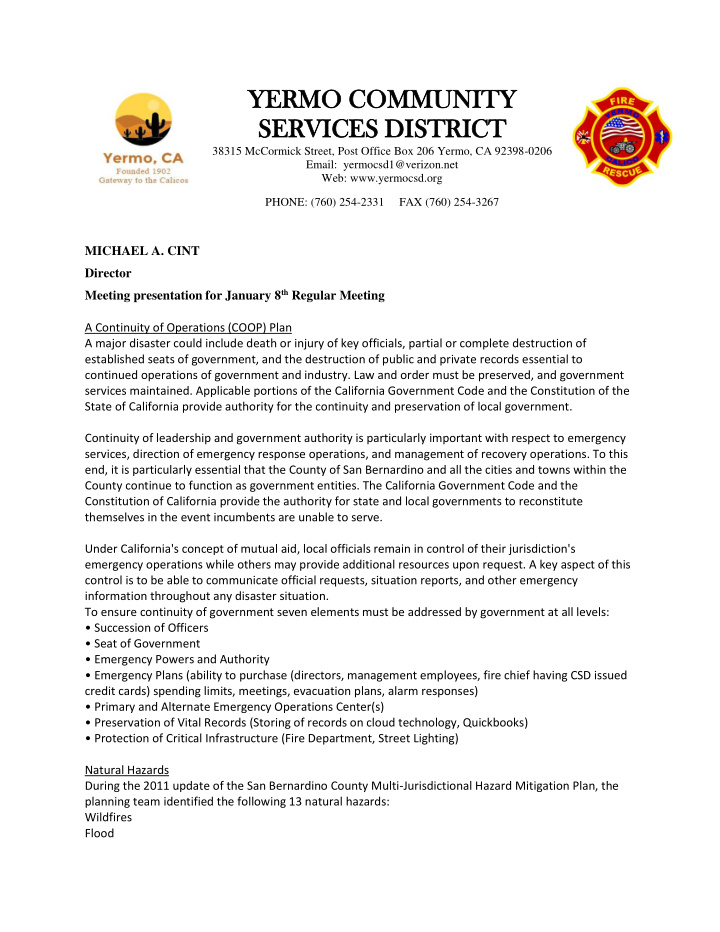



YERMO C RMO COMMU OMMUNITY NITY SE SERVIC RVICES DIS ES DISTRIC TRICT 38315 McCormick Street, Post Office Box 206 Yermo, CA 92398-0206 Email: yermocsd1@verizon.net Web: www.yermocsd.org PHONE: (760) 254-2331 FAX (760) 254-3267 MICHAEL A. CINT Director Meeting presentation for January 8 th Regular Meeting A Continuity of Operations (COOP) Plan A major disaster could include death or injury of key officials, partial or complete destruction of established seats of government, and the destruction of public and private records essential to continued operations of government and industry. Law and order must be preserved, and government services maintained. Applicable portions of the California Government Code and the Constitution of the State of California provide authority for the continuity and preservation of local government. Continuity of leadership and government authority is particularly important with respect to emergency services, direction of emergency response operations, and management of recovery operations. To this end, it is particularly essential that the County of San Bernardino and all the cities and towns within the County continue to function as government entities. The California Government Code and the Constitution of California provide the authority for state and local governments to reconstitute themselves in the event incumbents are unable to serve. Under California's concept of mutual aid, local officials remain in control of their jurisdiction's emergency operations while others may provide additional resources upon request. A key aspect of this control is to be able to communicate official requests, situation reports, and other emergency information throughout any disaster situation. To ensure continuity of government seven elements must be addressed by government at all levels: • Succession of Officers • Seat of Government • Emergency Powers and Authority • Emergency Plans (ability to purchase (directors, management employees, fire chief having CSD issued credit cards) spending limits, meetings, evacuation plans, alarm responses) • Primary and Alternate Emergency Oper ations Center(s) • Preservation of Vital Records (Storing of records on cloud technology, Quickbooks) • Protection of Critical Infrastructure (Fire Department, Street Lighting) Natural Hazards During the 2011 update of the San Bernardino County Multi-Jurisdictional Hazard Mitigation Plan, the planning team identified the following 13 natural hazards: Wildfires Flood
Earthquake/Geologic Hazards Infestation Drought High Winds/Straight Line Winds Lightning Extreme Heat Extreme Cold Hail Tornado Winter Storm (Heavy Snowfall) Industrial / Technological / Man-Made Hazards In addition to natural hazards, the County may be faced with the following industrial, technological or man-made hazards: Civil Unrest Public Safety Communications Failure Terrorism Utility Failure/Power Disruption Public Health Hazards/Epidemics Train Derailment Hazardous Materials Incident Airplane Crash Mass Fatalities Incident Public trust The concept of the public trust relates back to the origins of democratic government and its seminal idea that within the public lies the true power and future of a society; therefore, whatever trust the public places in its officials must be respected. It pertains to the Yermo CSD in many ways; accurate financial disclosures during reports, quarterly internal audits identifying strengths and weaknesses, accurate accounting, documentation and transparency (time clocks, 3 rd party verification (accountants, auditors) and policies and procedures that are followed for all and not waived because they are difficult or uncomfortable. (background checks, employment checks) We must also strive to ensure we put items on the meeting agendas that ensure the peoples business is being done. Agenda items that create “ gotcha moments ” or are designed to embarrass or humiliate board members, staff and/or the public should be avoided. Addressing any concerns or questions internally so issues are not “blindsided” can help with board morale and cohesion. Transparency In 2018, the District website was transition to a cheaper, more efficient model. This was in anticipation of two upcoming pieces of legislature: 1. Agendas on Website: beginning Jan. 2019, due to AB 2257, districts must put a link directly to the “ most recent" agenda directly on the home page, and agendas must be "retrievable,
downloadable, indexable, and electronically searchable by commonly used Internet search applications...platform independent and machine readable." (This sounds scary, but a text based PDF works for this, until someone tells you differently!) 2. All special districts to have a website by January 1, 2020. Senate Bill 929 — The Special Districts Transparency Act — was signed into law by Governor Jerry Brown in September. The following requirements for the district are mandated to be in effect now: 1. Establish and maintain a website that is Section 508 / ADA compliant by January 2020 (existing sites must be Section 508 compliant now). 2. Post contact information for the district on the website (new SB 929 requirement). 3. Post agendas to the website at least 72 hours in advance of each regular meeting, in a format that is searchable, indexable, and platform-independent (save directly to PDF from Word, for example). Put a link to the most recent agenda directly on the home page. 4. Post a link to the State Controller’s PublicPay website (or include the district’s most recent Compensation Report on the website). 5. Post a link to the State Controller’s ByTheNumbers website (or include the district’s most recent Financial Transaction Report on the website). 6. Post a link to the district’s Enterprise System Catalog in a “prominent location” on the website (required by July 2016).
Recommend
More recommend